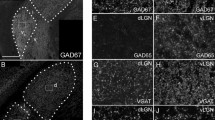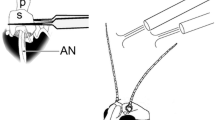Summary
The sensitivity of sensory neurons to target cell denervation varies in the CNS. We have examined the effects of surgically interrupting the output axons of the first optic neuropil, or lamina, in the optic lobe of the fly (Musca domestica), upon the receptor terminal inputs to the lamina. Two of the output interneurons are the monopolar cells L1 and L2, which are found as a pair in each of the unit modules or cartridges of the lamina neuropil. The lamina axons of LI and L2 degenerate rapidly (within 0.5 h) in a retrograde direction from their lesion site, but there is no sign of retrograde transneuronal degeneration to the receptor terminals, across the input synapse. At each of these synaptic sites, L1 and L2 are invariable contributors to two of the four elements of a postsynaptic tetrad. Not only do the receptor terminals persist, but the presynaptic ribbons at the tetrad sites do also, opposite the degenerated spines of L1 and L2, indicating their lack of target dependence at least over the longest period of post-lesion recovery (48 h) examined. The areal density of presynaptic sites was conserved in the face of the degenerative loss of L1 and L2, as were the numbers of capitate projections (glial invaginations into receptor terminals). The stability of both synaptic density and capitate projection number indicates that they are predominately influenced by the receptor terminals, which are still intact. A reduction in the number of mitochondrial profiles was one of the few observed changes in the receptor terminals. The results reflect the autonomy which the terminals have, during development, from their interneurons; they especially reflect the role of the terminals in the adult, in maintaining the presynaptic site of their afferent synapses, the tetrads.
Similar content being viewed by others
References
Boschek, C. B. (1971) On the fine structure of the peripheral retina and lamina ganglionaris of the fly,Musca domestica.Zeitschrift für Zellforschung und mikroskopische Anatomie 118, 369–409.
Braitenberg, V. (1970) Ordnung und Orientierung der Elemente im Sehsystem der Fliege.Kybernetik 7, 235–42.
BrandstÄtter, J. H., Shaw, S. R. &Meinertzhagen, I. A. (1991a) Terminal degeneration and synaptic disassembly following receptor photoablation in the retina of the fly's compound eye.Journal of Neuroscience 11, 1930–41.
Brandstätter, J. H., Shaw, S. R. &Meinertzhagen, I. A. (1991b) Invagination of presynaptic ribbons in the fly's optic lobe following loss of their target neuron.Proceedings of the Royal Society of London, Series B 245, 13–22.
Brandstätter, J. H., Shaw, S. R. &Meinertzhagen, I. A. (1992) Reactive synaptogenesis following degeneration of photoreceptor terminals in the fly's optic lobe: a quantitative-electron microscopic study.Proceedings of the Royal Society of London, Series B 247, 1–7.
Burkhardt, W. &Braitenberg, V. (1976) Some peculiar synaptic complexes in the first visual ganglion of the fly,Musca domestica.Cell and Tissue Research 173, 287–308.
Campos, A. R., Fischbach, K.-F. &Steller, H. (1992) Survival of photoreceptor neurons in the compound eye ofDrosophila depends on connections with the optic ganglia.Development 114, 355–66.
Campos-Ortega, J. A. &Strausfeld, N. J. (1973) Synaptic connections of intrinsic cells and basket arborizations in the external plexiform layer of the fly's eye.Brain Research 59, 119–36.
Combes, P. C., Privat, A., Pessac, B. &Calothy, G. (1977) Differentiation of chick embryo neuroretina cells in monolayer cultures. An ultrastructural study. I. Seven-day retina.Cell and Tissue Research 185, 159–73.
Cowan, W. M. (1970) Anterograde and retrograde transneuronal degeneration in the central and peripheral nervous system. InContemporary Research Methods in Neuroanatomy (edited byNauta, W. J. H. &Ebbesson, S. O. E.) pp. 217–51. New York: Springer-Verlag.
Elliot, E. J. &Muller, K. J. (1981) Long-term survival of glial segments during nerve regeneration in the leech.Brain Research 218, 99–113.
Fröhlich, A. (1985) Freeze-fracture study of an invertebrate multiple-contact synapse: the fly photoreceptor tetrad.Journal of Comparative Neurology 241, 311–26.
Fröhlich, A. &Meinertzhagen, I. A. (1982) Synaptogenesis in the first optic neuropile of the fly's visual system.Journal of Neurocytology 11, 159–80.
Fröhlich, A. &Meinertzhagen, I. A. (1987) Regulation of synaptic frequency: comparison of the effects of hypoinnervation with those of hyperinnervation in the fly's compound eye.Journal of Neurobiology 18, 343–57.
Griffiths, G. W. &Boschek, C. B. (1976) Rapid degeneration of visual fibers following retinal lesions in the dipteran compound eye.Neuroscience Letters 3, 253–8.
Guth, L. (1971) Degeneration and regeneration of taste buds. InHandbook of Sensory Physiology, Vol. 4/2,Taste (edited byBeidler, L. M.) pp. 63–74. Berlin, Heidelberg, New York: Springer-Verlag.
Koenig, J. H. &Ikeda, K. (1989) Disappearance and reformation of synaptic vesicle membrane upon transmitter release observed under reversible blockage of membrane retrieval.Journal of Neuroscience 9, 3844–60.
Kral, K. &Meinertzhagen, I. A. (1989) Anatomical plasticity of synapses in the lamina of the optic lobe of the fly.Philosophical Transactions of the Royal Society of London, Series B 323, 155–83.
Krogh, A. &Weis-Fogh, T. (1951) The respiratory exchange of the desert locust (Schistocerca gregaria) before, during and after flight.Journal of Experimental Biology 28, 344–57.
Laughlin, S. B., Howard, J. &Blakeslee, B. (1987) Synaptic limitations to contrast coding in the retina of the blowflyCalliphora.Proceedings of the Royal Society of London, Series B 231, 437–67.
Lehninger, A. L. (1962) Water uptake and extrusion by mitochondria in relation to oxidative phosphorylation.Physiological Reviews 42, 467–517.
Marcey, D. J. &Stark, W. S. (1985) The morphology, physiology, and neural projections of supernumerary compound eyes inDrosophila melanogaster.Developmental Biology 107, 180–97.
Meinertzhagen, I. A. (1973) Development of the compound eye and optic lobe of insects. InDevelopmental Neurobiology of Arthropods (edited byYoung, D.) pp. 51–104. Cambridge: Cambridge University Press.
Meinertzhagen, I. A. (1976) The organisation of perpendicular fibre pathways in the insect optic lobe.Philosophical Transactions of the Royal Society of London, Series B 274, 555–94.
Meinertzhagen, I. A. (1989) Fly photoreceptor synapses: their development, evolution, and plasticity.Journal of Neurobiology 20, 276–94.
Meinertzhagen, I. A. &O'Neil, S. D. (1991) Synaptic organization of columnar elements in the lamina of the wild type inDrosophila melanogaster.Journal of Comparative Neurology 305, 232–63.
Mojet, M. H., Tinbergen, J. &Stavenga, D. G. (1991) Receptor potential and light-induced mitochondrial activation in blowfly photoreceptor mutants.Journal of Comparative Physiology A 168, 305–12.
Nicol, D. &Meinertzhagen, I. A. (1982) An analysis of the number and composition of the synaptic populations formed by photoreceptors of the fly.Journal of Comparative Neurology 207, 29–44.
Parker, G. H. (1932) On the trophic impulse so-called, its rate and nature.American Naturalist 66, 147–58.
Purves, D. (1988)Body and Brain. Cambridge: Harvard University Press.
Sachs, L. (1984)Angewandte Statistik. Berlin, Heidelberg, New York: Springer-Verlag.
Shaw, S. R. (1984) Early visual processing in insects.Journal of Experimental Biology 112, 225–51.
Shaw, S. R., Fröhlich, A. &Meinertzhagen, I. A. (1989) Direct connections between the R7/8 and R1-6 photo-receptor subsystems in the dipteran visual system.Cell and Tissue Research 257, 295–302.
Shaw, S. R. &Meinertzhagen, I. A. (1986) Evolutionary progression at synaptic connections made by identified homologous neurones.Proceedings of the National Academy of Sciences (USA) 83, 7961–5.
Sivasubramanian, P. &Stark, W. S. (1980) Photoreceptor properties of an ectopic eye in the fleshfly,Sarcophaga bullata.Experientia 36, 993–4.
Stark, W. S. &Carlson, S. D. (1986) Ultrastructure of capitate projections in the optic neuropil of Diptera.Cell and Tissue Research 246, 481–6.
Stark, W. S. &Sapp, R. (1989) Retinal degeneration and photoreceptor maintenance inDrosophila: rdgB and its interaction with other mutants. InInherited and Environmentally Induced Retinal Degenerations (edited byLavail, M. M., Anderson, R. E. &Hollyfield, J. G.) pp. 467–89. New York: A. R. Liss.
Strausfeld, N. J. (1971) The organization of the insect visual system (light microscopy). II. The projection of fibres across the first optic chiasma.Zeitschrift für Zellforschung und mikroskopische Anatomie 121, 442–54.
Strausfeld, N. J. &Campos-ortega, J. A. (1977) Vision in insects: pathways possibly underlying neural adaptation and lateral inhibition.Science 195, 894–7.
Strausfeld, N. J. &Nässel, D. R. (1980) Neuroarchitectures serving compound eyes of Crustacea and insects. InHandbook of Sensory Physiology Vol. VII/6B,Comparative Physiology and Evolution of Vision in Invertebrates (edited byAutrum, H.) pp. 1–132. Berlin: Springer-Verlag.
Tinbergen, J. &Stavenga, D. G. (1987) Spectral sensitivity of light induced respiratory activity of photoreceptor mitochondria in the intact fly.Journal of Comparative Physiology A160, 195–203.
Townes-Anderson, E., MacLeish, P. R. &Raviola, E. (1985) Rod cells dissociated from mature salamander retina: ultrastructure and uptake of horseradish peroxidase.Journal of Cell Biology 100, 175–88.
Trujillo-Cenóz, O. (1965) Some aspects of the structural organization of the intermediate retina of dipterans.Journal of Ultrastructure Research 13, 1–33.
Trujillo-Cenóz, O. &Melamed, J. (1975) Transplanted eyes of dipterans.Naturwissenschaften 62, 42–3.
Tzagoloff, A. (1982)Mitochondria. New York: Plenum.
Author information
Authors and Affiliations
Rights and permissions
About this article
Cite this article
Brandstätter, J.H., Seyan, H.S. & Meinertzhagen, I.A. The effects of the loss of target cells upon photoreceptor inputs in the fly's optic lobe. J Neurocytol 21, 693–705 (1992). https://doi.org/10.1007/BF01181585
Received:
Revised:
Accepted:
Issue Date:
DOI: https://doi.org/10.1007/BF01181585




